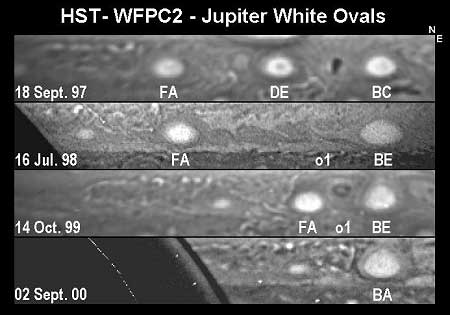Global warming on Jupiter
What the science says...
| Select a level... |
 Basic
Basic
|
 Intermediate
Intermediate
| |||
| Jupiter's climate change is due to shifts in internal turbulence fueled from an internal heat source - the planet radiates twice as much energy as it receives from the sun. | |||||
Climate Myth...
Jupiter is warming
"A new storm and a new red spot on Jupiter hints at climate change, USA TODAY and dozens of other sources explained yesterday. The temperatures are expected to change by as much as 10 Fahrenheit degrees at different places of the globe. At least close to the new spot and to the equator, nothing less than global warming is expected" (source: The Reference Frame).
Between 1998 and 2000, three White Ovals (giant vortices) on Jupiter merged and formed a new oval, approximately the size of Earth. Initially, it was white but it turned brown and then red in 2005. The official name of the red spot is "Oval BA" although it's more popular nickname "Red Spot Jr" has considerably more cachet.

Steps in the consolidation of three "white oval" storms into one over a three-year span of time.
What fuels Jupiter's storms?
On Jupiter, the sun's energy is only 4% of the level we receive on earth, nowhere near enough to fuel its turbulent, planet-sized storms. Jupiter radiates into space more than twice the heat it absorbs from the sun. This internal heat source, via moist convection, converts heat flow into the kinetic energy that fuels Jovian storms (Ingersoll 2000, Gierasch 2000).
How is Jupiter's climate changing?
Temperature is relatively uniform on Jupiter - the temperature at the poles is nearly the same as at the equator. This is due to the chaotic mixing of heat and airflow from vortices (eg - the White Ovals). The oscillatory motions of the White Ovals ceased after they merged, dampening the movement of heat from Jupiter's equator to its south pole. The latitudes near 34°S, the same latitude where Red Spot Junior is located, are predicted to become barriers preventing the mixing of heat and airflow. If so, Jupiter's equatorial regions will become warmer and its poles will become cooler. Average temperature at some latitudes could change by as much as 5.5° Celsius (Marcus 2006).
In other words, what is predicted is not global warming on Jupiter but a change in the distribution of heat with the equator getting hotter and the poles cooling. It's also worth mentioning this climate change is yet to be observed - it's a prediction based on the modelling of the disappearing white ovals.
Implications for Earth's climate
While Jupiter's storms are fueled from an internal heat source, Earth's climate gets its energy from the sun (which hasn't shown any long term warming trend for over 50 years). Additionally, Jupiter's climate change is due to shifts in internal turbulence rather than an external forcing. So what is the connection between Jupiter's climate change and Earth's global warming? There is none.
Last updated on 26 June 2010 by John Cook.































 Arguments
Arguments
































Secondly, the solar flux at Jupiter is roughly 55 W/m2. But Jupiter only absorbs solar energy on the half of the planet facing the sun. Eg - the area that absorbs solar energy at 55 W/m2 is a circle with the same radius as Jupiter. The area of a circle = pi x r2. Hence, the total amount of solar energy absorbed by Jupiter = 55 x pi x r2 Watts = 172 r2 Watts .
In other words, Jupiter emits about 2.4 times as much energy as it absorbs from the sun. Thanks for your research in quantifying the incoming and outgoing radiation. I've updated the text from "almost twice as much" to "more than twice as much".There are actually "5 thrusts" to my post, any one of which puts paid to the idea that climate change on Jupiter is due to a warming sun:
- Jupiter's storms are fueled internally, not by the sun
- The changes occuring (eg - disappearance of vortices, creation of Red Spot Jr) are the result of internal turbulence, not an external forcing
- Global warming isn't happening on Jupiter - it's a change in the distribution of energy with more in the equator, less in the poles due to disappearing vortices
- The climate change cited by skeptics (changes of 10 degrees) haven't even been observed yet - they are model predictions
- The sun isn't getting hotter
However, I appreciate your tenacity and hard work in researching Jovian climate - the comments have been engrossing and John Cross will be chuffed to find a paper on the impact of Shoemaker Levi as that was what got me started on Jupiter in the first place.